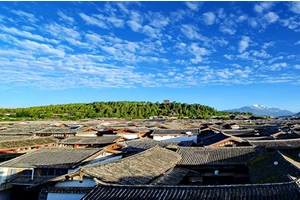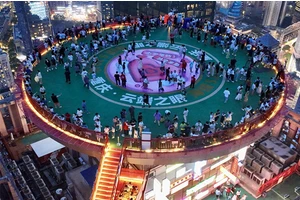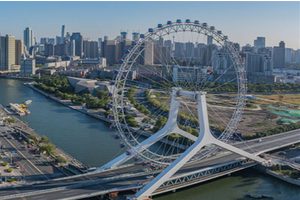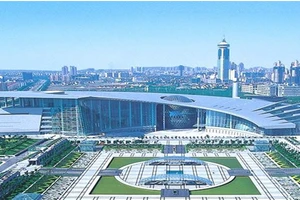Hebei town tourism
Hebei town has a long history, beautiful scenery, surrounded by green mountains, green water rushing, mountain springs pouring, strange peaks and many cultural relics. There are not only Shihua Cave, one of the four famous caves in China, but also Jiangjuntuo and Qiaomaishan scenic spots under development. There are still some tourist resources to be developed, such as the Flower Pagoda in Tang Dynasty, Tiewa Temple and Lianquan Temple in Ming Dynasty, Sun Bin and Pang Juan learning art platforms in Warring States Period, Wang Yefen in Qing Dynasty, and Zhangliangdong, Yuchan Cave, Kongshui Cave and Bat Cave, which have the basic conditions for developing tourism.
There are one cave, two villages and four gardens in Hebei town.
One hole: Shihua Cave in the National AAAA Geopark;
Second Village: Banbidian Folk Tourism Village and Huangtupo Folk Tourism Village;
Four Gardens: Banbidian Picking Sightseeing Garden, Jiangjuntuo Picking Leisure Sightseeing Garden, Suoyugou Picking Leisure Sightseeing Garden and Qiaomaishan Leisure Sightseeing Garden.
The scenic spots have complete infrastructure and excellent catering and accommodation conditions, among which Shihua Cave is the most famous, which can attract a large number of tourists and drive the tourism industry in the town. The existing Wanfo Hall in Hebei Town is a state-level cultural relics protection unit, and the exquisite Buddhist culture sculptures in the hall are lifelike; There are only two Tiewa Temple in the world, one in South Korea and the other in China, which is located in Hebei Town. It is now a municipal cultural relics protection unit and is applying for national cultural relics.
If Hebei town authorities are relocated and the potential value of Tiewa Temple is fully tapped, its influence will be immeasurable. Rebuild the Jiumiao Temple, Sanguan Temple and Lianquan Temple with great development value in the town; Together with Jietai Temple and Tanzhe Temple, which are only one step away, a distinctive Buddhist tourist route in western Beijing will be formed around Hebei Town.
1. Beijing Shihuadong National Geopark
Beijing Shihuadong National Geopark is located in Nancheying Village, Hebei Town, Fangshan District, Beijing, 55 kilometers away from Beijing. It is a seven-story cave with a height difference of 150 meters. Now all the first and second floors and the third and fourth floors have been opened to the public, with a tour length of 2500 meters.
Shihua Cave, formerly known as "Qianzhen Cave", has been discovered for more than 500 years. Because there are three marble Buddha statues carved in the cave, it was renamed as "Stone Buhhda Cavern", and the incense was once very popular.
Shihua Cave is a large-scale karst cave found in China, with many caves, all kinds of sediments and a large number of secondary chemical deposits. Its aesthetic value and scientific research value can also rank among the top caves in the world, and it is also known as the four major karst caves in China together with reed flute cave in Guilin, Yuhua Cave in Fujian and Yaolin Cave in Hangzhou.
2. Huangtupo Folk Village
Huangtupo Folk Village is adjacent to Shihuadong Scenic Area and Banbidian Folk Tourism Village of National Geopark, forming a circular tourism belt, which is located in the southeast of National Highway 108, southwest of Yanhe Road in S208, 45 kilometers away from the city center, with superior geographical position and convenient transportation. The village has a total area of 1,851.5 mu, with more than 400 natural households and a registered population of more than 760.
Huangtupo Folk Village is surrounded by mountains, with beautiful natural environment and rich agricultural resources. Relying on the tourism resources of Shihua Cave, and based on the natural scenery, flower and fruit picking, farming experience, mountaineering and leisure, Qingshi inkstone culture exhibition hall and other tourism projects in the village, crops do not use chemical fertilizers, pesticides and other chemicals.
Huangtupo Village has made great efforts to develop a new type of green and environmentally-friendly tourism industry that integrates tourism, leisure services and cultural health preservation, with safety first, experience first and harvest first, so as to create a "Huaxia Health Culture Village".
3. Jiangjuntuo Scenic Area
Jiangjuntuo Scenic Area is located in Tanmugang Village, Hebei Town, Fangshan District, Beijing. It is an ecological natural scenic spot with a total area of 1,680 mu, including 370 mu of orchards and 230 mu of scenic forests. The fruit trees include apricots, peaches, apples, walnuts and persimmons.
Baicaoyuan has Chrysanthemum morifolium, Bupleuri Radix, Adenophora adenophora, Wild Ginger, Forsythia suspensa, Platycodon grandiflorum and so on. It is a national A-level scenic spot. Main tour contents: mountain climbing, flower viewing, hiking, picking, summer vacation, etc.






